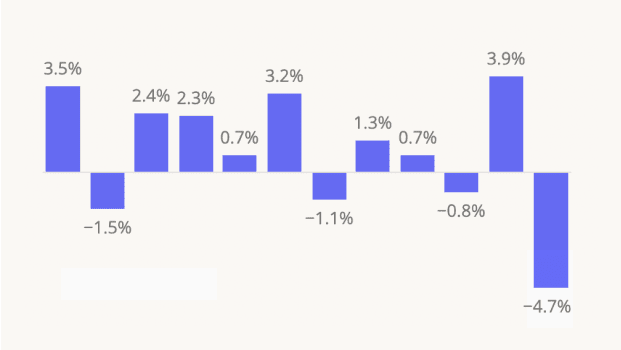Consumers have been taking stock of their habits and behaviors over the past few years. With the explosion of semaglutide medications in the market and the high frequency of adoption by consumers, there’s a renewed focus on health and wellness across the U.S. population that extends to other consumption behaviors. One of the outcomes of this change in perspective is the increased scrutiny around the consumption of alcoholic beverages – especially among younger consumers.
At the same time, alcohol consumption increased handily during the pandemic, which has helped liquor stores and retail chains to stand out from the rest of the retail industry. As we hit the five year anniversary of the beginning of the pandemic, it’s time to dive deeper into the Bev Alc space to uncover new trends, changes with consumer engagement, and potential headwinds for the industry.
Deceleration in Liquor Store Visit Growth in 2024
Liquor store chains benefited greatly from shifts in behavior during the pandemic, and for the most part, they’ve been able to sustain those levels of success over the past few years. However, 2024 signaled a deceleration of foot traffic growth across chains, particularly in the second half of the year.
Bev Alc had been a visitation leader in the essential side of the retail industry in the early days of the pandemic, and the category continued to benefit greatly from sustained levels of alcohol consumption even after pandemic restrictions eased. But as with all pandemic-era consumer habits, as we approach the five year anniversary, reversal of some trends are taking shape: While year-over-year visits continued to rise in 2024, last year’s 4.0% average increase in monthly visits was significantly less than the 8.6%, 9.1%, 7.1%, or 6.7% average increases in monthly visits in 2020, 2021, 2022, and 2023, respectively.
There are also various factors that could potentially impact the industry this year: Decreased consumption of alcohol that could have played a role in 2024’s softening of visits is likely to continue in 2025, and potential tariffs on popular spirits like Tequila and Mezcal may impact consumer preferences going forward.
Spec’s Outperformed the Bev Alc Category in 2024
From a retailer perspective, Spec’s posted the strongest visit performance while BevMo! had the most challenging 2024 of the larger liquor retail chains, although most chains experienced some softening in foot traffic throughout the year. Bev Alc retail is a notoriously regional and local category, meaning that changes in foot traffic by chain are often impacted by what’s going on in a specific region of the U.S. BevMO! services Arizona, California and Washington, so the chain’s modest performance may point to some decreases in demand across the western part of the country. Meanwhile, Spec’s operates primarily in Texas, and its consistent YoY visit growth throughout 2024 may suggest that the shift in alcohol consumption habits has been more muted in the Lone Star State.
What’s Driving Liquor Store Visitation Shifts?
With the broader context of what’s going on across the category analyzed, what’s really driving these changes in visitation to liquor stores? As referenced, there’s been a narrative that younger consumers’ changing alcohol consumption habits will greatly impact the Bev Alc space.
But layering Spatial.ai’s Personalive demographic and psychographic visitor segmentation onto liquor store’s captured market reveals a slightly more nuanced reality. The data shows that between 2019 and 2024, the share of wealthier families and of Educated Urbanites – a younger, well-educated, and more affluent cohort – in the captured market of liquor stores. During the same period, the share of Young Professionals and Young Urban Singles – both segments of younger visitors have lower median household incomes than Educated Urbanites – actually increased.
What the data reveals is that we can’t build a singular narrative around the alcohol habits of all younger consumers; there’s also a layer of socioeconomics that has also impacted consumers' desire to frequent liquor stores and engage in alcohol consumption. This knowledge may also contribute to the changes we’ve seen in BevMo!’s business, as their highest shares of visitation come from wealthier families and Educated Urbanites.
Shifts in Visit Times
Foot traffic estimates also reveal that consumers have shifted the time of day that they visit liquor store chains. In 2024, we observed a higher share of visits after 3 PM compared to 2019, with the largest penetration shift coming between the hours of 6 PM to 8 PM. Consumers are visiting liquor stores more frequently after working hours than before the pandemic, which underscores the shifting role of alcohol in people’s lives. Our data also indicated a higher distribution of visits during weekdays in 2024 compared to 2019, but a lower share of weekend visits.
Liquor store visit frequency contextualizes the changes that we’ve observed in consumption habits, highlighting that, despite the increased interest in moderating drinking habits, the pandemic did fundamentally shift how people engage with the category and alcohol retail has become more of a presence in consumers’ weekly routines.
Adapting to Shifting Consumer Preferences
As the cultural perception of alcohol shifts, changes are likely to occur across the industry. We’ve observed more liquor brands opening bars and drinking establishments to engage directly with consumers, while there’s also still a continued rise in local and regional brands popping up. Another area that has been growing steadily over the past few years is non-alcoholic beverages. The aisles of grocery stores and liquor stores are now filled with non-alcoholic alternatives of brand names, as well as mocktail entrants into wildly popular canned cocktails. Beyond that, there’s also been an increase in the number of non-alcoholic bottle shops, and the prevalence of non-alcoholic options will likely continue to grow and extend to other areas of the country outside of major cities. The Bev Alc industry is at a true crossroads with consumers, and consumer behavior will dictate how the industry must evolve to stay relevant.




.png)
.png)

.png)
.png)














.svg)